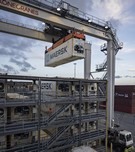(More of) Savannah is open for business. That’s the message following a recently announced expansion to the Port of Savannah by the Georgia Ports Authority (GPA).
In late January, the GPA board approved the construction of seven additional refrigerated container (i.e. reefer container) racks at the port. In all, the $6.2 million project will grow the number of slots for cold cargo to 3,506 at Garden City Terminal, counting chassis plug-ins. Savannah’s Ocean Terminal provides another 368 refrigerated container plugs. Construction on the seven reefer racks will take a year to complete.
“Adding capacity to our terminal is certainly going to benefit the importers as more and more customers, especially fresh produce customers, look to Savannah as the new gateway to bring product into the Southeast,” says Judd Bare, regional sales manager, trade development for the Georgia Port Authority.
 Left to right: Flavio Batista, Judd Bare
Left to right: Flavio Batista, Judd Bare
Key import items
In fresh produce, there are a number of items traveling through the port, starting with Hass avocados. “This is growing tremendously here--there are avocados coming out of Peru, but we’re also starting to see them come out of Colombia who can grow them year-round,” says Bare. In addition, citrus imports have been on the rise through the port. In 2022, the port saw its first load of South African citrus and managed 700-800 full container loads of citrus from South Africa that year. “I’m hopeful we’ll double that this year,” says Bare. Other items include Peruvian and Chilean grapes, Italian and Moroccan kiwis and onions which complement the domestic onion season. In total, the port handles some 150,000 loaded twenty-foot equivalent container units per year of refrigerated and frozen cargo.
The port is hoping to expand those items from a number of countries. “There’s a lot of citrus being produced and imported into the U.S. via countries like Spain or Morocco. The added capacity certainly allows us to focus on new markets and new business to the port,” says Bare. He notes that the shift in consumers to more health-minded thinking via the pandemic is when GPA started to see more and more perishable items coming through Savannah.
Third-party logistics  Along with the expansion inside the port comes growth outside of it, too. “Because we’re making an investment and more reefer containers are coming through the port, there’s investment outside the port. The whole supply chain ecosystem is being expanded,” says Flavio Batista, vice-president sales and marketing for the GPA.
Along with the expansion inside the port comes growth outside of it, too. “Because we’re making an investment and more reefer containers are coming through the port, there’s investment outside the port. The whole supply chain ecosystem is being expanded,” says Flavio Batista, vice-president sales and marketing for the GPA.
This includes the network of cold storage warehousing growing outside the port. Presently, two major players in perishable cargo storage operate within the Savannah market – Americold and Lineage Logistics, which just opened a new facility in Savannah. Bare says a list of companies are looking to add cold storage warehouse spaces with repack services, fumigation services, cold treatment and more.
That latter service is particularly critical. “We’re certified with the USDA to finish cold treatment and there are local third-party logistics handlers who can also finish cold treatment in their facilities,” says Bare. “That’s what differentiates us from a Port Miami or Port of Charleston. It’s really only Philadelphia, Houston and Savannah that can handle that cold treatment.”
 For more information:
For more information:
Edward Fulford
Georgia Ports Authority
efulford@gaports.com
https://gaports.com/
